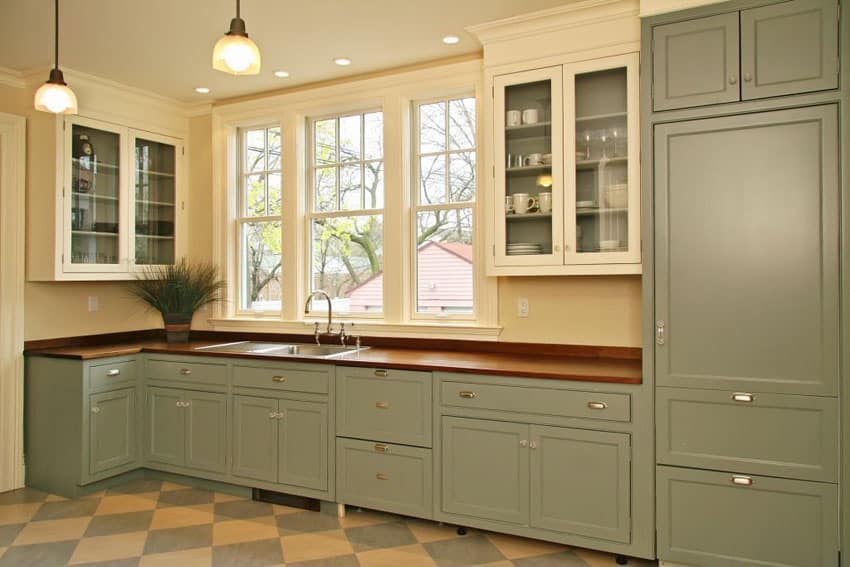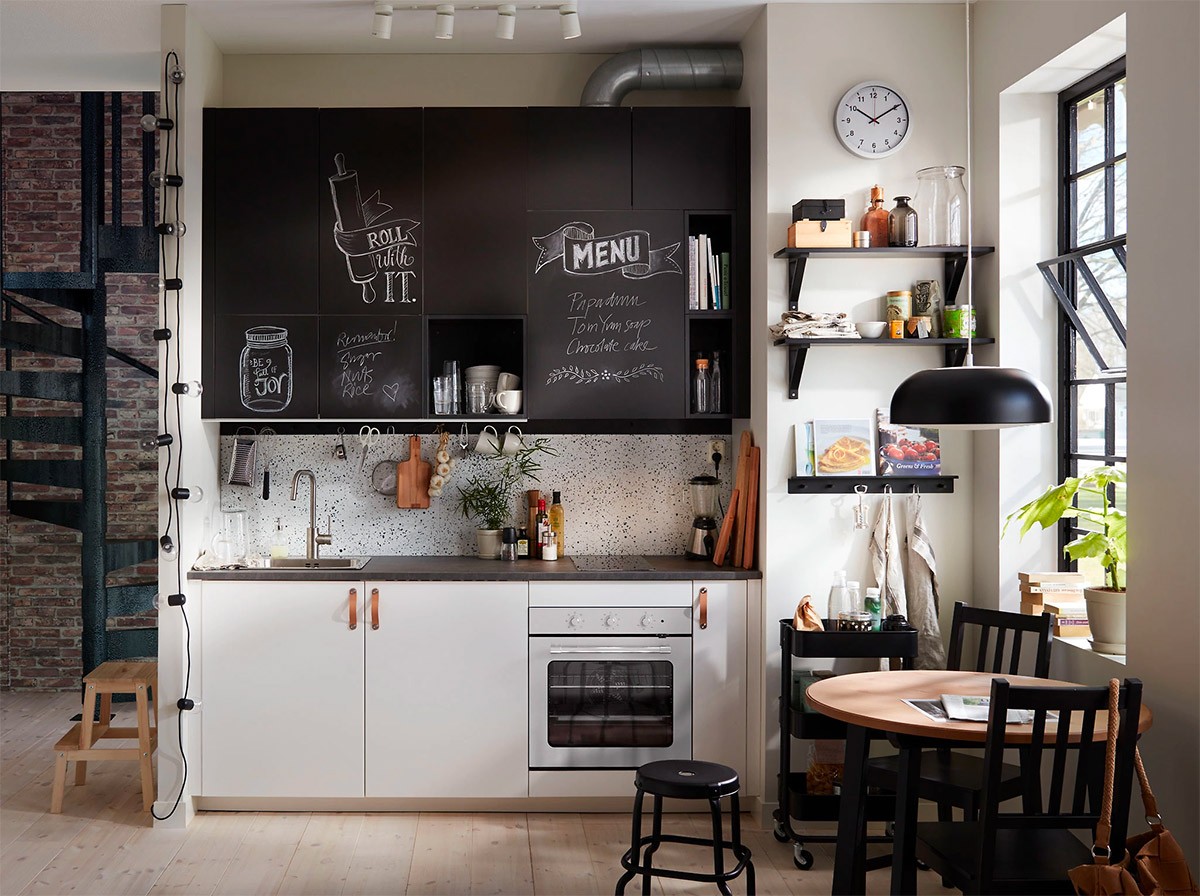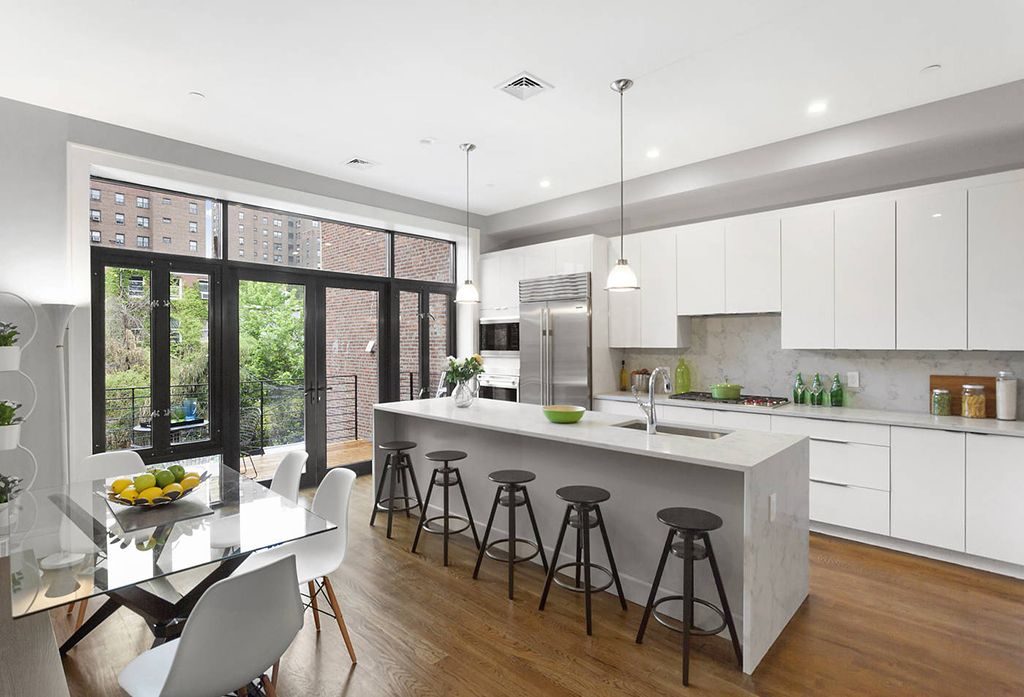Advantages of Single-Wall Kitchen Cabinets: Kitchen Cabinets On One Wall Only

A single-wall kitchen cabinet setup can be a stylish and practical choice for smaller kitchens or those seeking a minimalist aesthetic. By concentrating cabinets on one wall, you can create a spacious and airy environment while maximizing functionality.
Space-Saving Benefits
A single-wall kitchen design offers a significant advantage in terms of space utilization. By concentrating cabinets on one wall, you free up valuable floor space, making the kitchen feel larger and more open. This is particularly beneficial in smaller kitchens where every inch counts. For example, a single-wall kitchen can create a more spacious feel than a traditional galley kitchen with cabinets on two walls, especially in smaller spaces.
Open and Airy Kitchen Feel
A single-wall kitchen layout can create a more open and airy feel compared to traditional kitchen designs. This is because the absence of cabinets on other walls allows for uninterrupted sightlines and a sense of openness. The open space also allows natural light to flow more freely throughout the kitchen, enhancing the overall ambiance.
Maximizing Natural Light
Single-wall kitchen designs can be strategically planned to maximize natural light. By placing windows on the wall opposite the cabinets, you can create a bright and welcoming kitchen space. This is especially important in kitchens that lack natural light sources. A single-wall design can be ideal for maximizing natural light in kitchens with windows on one side, as it allows for unobstructed light penetration.
Storage and Functionality
Single-wall kitchen cabinets can be designed to maximize storage and functionality. By incorporating clever storage solutions like pull-out shelves, deep drawers, and vertical organizers, you can optimize space and keep your kitchen organized.
For example, consider incorporating a pantry cabinet on the single wall, which can accommodate a wide range of items, from groceries to kitchen appliances.
Cost Savings
Single-wall kitchen cabinet installations can often be more cost-effective than traditional layouts. This is because you require fewer cabinets, which translates to lower material costs. Additionally, the simpler design often requires less labor, further reducing installation expenses.
For example, a single-wall kitchen cabinet installation could cost around 20% less than a traditional U-shaped kitchen with cabinets on three walls, depending on the size and complexity of the project.
Design Considerations for Single-Wall Kitchen Cabinets

A single-wall kitchen offers a unique challenge and opportunity for design. It necessitates careful planning to maximize functionality and aesthetics within a limited space. This design approach requires strategic considerations regarding cabinet styles, materials, appliances, and countertop selections.
Cabinet Styles and Materials
Choosing the right cabinet style and materials is crucial for a single-wall kitchen. Consider the overall aesthetic and functionality you desire.
- Cabinet Styles: Sleek, modern cabinets with minimal hardware can create a sense of spaciousness. Shaker-style cabinets offer a classic, timeless look that complements various design aesthetics. Consider open shelving for displaying items and adding visual interest.
- Materials: Durable and easy-to-clean materials are essential. Laminate cabinets offer affordability and a wide range of colors and finishes. For a more luxurious look, consider wood cabinets, such as maple, cherry, or walnut.
Appliance Selection and Countertop Materials
Appliance selection and countertop materials play a significant role in creating a cohesive and functional single-wall kitchen.
- Appliance Selection: Opt for compact appliances to save space. Consider a slim refrigerator, a compact dishwasher, and a microwave that can be mounted above the stove. Integrated appliances, where the front panels blend seamlessly with the cabinetry, can create a streamlined look.
- Countertop Materials: Durable and easy-to-clean materials are essential for countertops. Quartz is a popular choice for its durability, stain resistance, and wide range of colors. Granite offers a natural look and unique patterns, while laminate is a budget-friendly option.
Essential Features for Functionality and Aesthetics, Kitchen cabinets on one wall only
Incorporating specific features can enhance the functionality and aesthetics of a single-wall kitchen.
- Lighting: Adequate lighting is essential for a functional kitchen. Consider under-cabinet lighting to illuminate work surfaces, and pendant lights or track lighting to provide general illumination.
- Backsplash: A backsplash adds visual interest and protects the wall behind the countertops. Consider using a material that complements the countertop and cabinet finishes.
- Storage Solutions: Maximize storage space with pull-out shelves, lazy susans, and vertical organizers.
Examples of Single-Wall Kitchen Designs
- Small Apartment Kitchen: A single-wall layout with a compact refrigerator, a two-burner cooktop, and a small sink can efficiently utilize limited space. Open shelving can create a sense of spaciousness and display decorative items.
- Open-Concept Kitchen: A single-wall kitchen can seamlessly integrate with an open-concept living area. Consider using a combination of cabinets, open shelving, and a breakfast bar to create a cohesive and functional space.
Planning and Installation of Single-Wall Kitchen Cabinets

Planning and installing single-wall kitchen cabinets can be a rewarding DIY project, allowing you to create a functional and stylish kitchen space. This approach is especially popular in smaller kitchens or those with limited space, maximizing the available area while creating a visually appealing design.
Designing a Single-Wall Kitchen Cabinet Layout
Before starting any installation, careful planning is essential. This involves determining the size and layout of your cabinets, considering the available space and your specific needs.
- Measure the wall space: Start by accurately measuring the available wall space, taking into account any obstructions like windows, doors, or electrical outlets. Be sure to measure the height, width, and depth of the wall space to ensure your cabinets will fit comfortably.
- Consider your appliances: If your kitchen includes appliances like a refrigerator, dishwasher, or oven, factor their dimensions into your cabinet layout. Leave sufficient space around these appliances for easy access and functionality.
- Decide on cabinet types: Choose from various cabinet types, such as base cabinets, wall cabinets, and pantry cabinets. Base cabinets provide storage space below the countertop, while wall cabinets offer overhead storage. Pantry cabinets are ideal for storing bulk food items.
- Create a layout plan: Use graph paper or a digital design tool to create a detailed layout plan of your single-wall kitchen. This plan should clearly show the placement of each cabinet, including their dimensions and the distance between them.
- Consider functionality and aesthetics: Think about how you will use the kitchen and what storage needs you have. Choose cabinet styles and finishes that complement your existing décor and create a visually pleasing aesthetic.
Importance of Accurate Measurements and Professional Installation
Accurate measurements are crucial for a successful single-wall kitchen cabinet installation. Incorrect measurements can lead to misaligned cabinets, gaps, or a poorly fitted kitchen. Professional installation ensures that your cabinets are installed correctly and securely, maximizing their functionality and longevity.
- Precise measurements: Use a tape measure to carefully measure the wall space, taking into account any existing trim or molding. Measure twice, and if necessary, thrice, to ensure accuracy.
- Level and plumb installation: Professional installers use specialized tools to ensure that cabinets are level and plumb, creating a stable and aesthetically pleasing installation.
- Secure fastening: Cabinets should be securely fastened to the wall using appropriate screws and anchors, ensuring they can withstand the weight of the contents and daily use.
- Professional finishing: Experienced installers can provide professional finishing touches, including trimming, caulking, and painting, to create a seamless and elegant look.
Tips for Creating a Functional and Aesthetically Pleasing Single-Wall Kitchen Cabinet Arrangement
When designing a single-wall kitchen cabinet arrangement, it’s essential to consider both functionality and aesthetics. A well-designed layout maximizes storage space, provides easy access to frequently used items, and enhances the overall appeal of the kitchen.
- Optimize storage: Use a combination of cabinet types and sizes to create a storage system that meets your specific needs. For example, deep base cabinets are great for storing larger items, while upper cabinets can hold less frequently used items.
- Create a work triangle: The work triangle concept, which refers to the arrangement of the sink, stove, and refrigerator, is crucial for kitchen efficiency. Aim for a work triangle layout that allows for smooth movement and easy access to these essential appliances.
- Incorporate open shelving: Open shelving can add visual interest and provide easy access to frequently used items. Consider using open shelving for displaying decorative items, cookbooks, or spices.
- Use contrasting colors and finishes: Create a visually appealing kitchen by using contrasting colors and finishes for your cabinets. For example, you could use a dark base cabinet with a light upper cabinet to create a sense of depth and visual interest.
- Add decorative elements: Accessorize your single-wall kitchen with decorative elements, such as cabinet hardware, lighting, and backsplash tiles. These elements can add personality and style to your kitchen.
Essential Tools and Materials for Single-Wall Kitchen Cabinet Installation
The following table Artikels the essential tools and materials needed for a successful single-wall kitchen cabinet installation.
| Tools | Materials |
|---|---|
| Tape measure | Cabinets |
| Level | Countertop |
| Stud finder | Cabinet hardware |
| Drill | Screws |
| Saw | Caulk |
| Screwdriver | Paint or stain |
| Hammer | Finishing nails |
Step-by-Step Guide for Installing Single-Wall Kitchen Cabinets
The following steps provide a general guide for installing single-wall kitchen cabinets. Remember to consult the manufacturer’s instructions for specific details and recommendations.
- Prepare the wall: Ensure the wall is clean, smooth, and free of any debris. If necessary, repair any cracks or holes using patching compound.
- Locate studs: Use a stud finder to locate the wall studs. Mark the stud locations on the wall for reference.
- Install base cabinets: Start by installing the base cabinets. Align the cabinets with the wall, ensuring they are level and plumb. Secure the cabinets to the wall studs using screws and anchors.
- Install wall cabinets: Once the base cabinets are in place, install the wall cabinets. Align the cabinets with the wall and the base cabinets, ensuring they are level and plumb. Secure the cabinets to the wall studs using screws and anchors.
- Install countertop: After the cabinets are installed, install the countertop. Cut the countertop to the desired size and shape, and secure it to the base cabinets using appropriate fasteners.
- Install cabinet hardware: Install the cabinet hardware, such as hinges, knobs, and pulls. Ensure the hardware is properly aligned and secured.
- Finish the installation: Finish the installation by applying caulk around the edges of the cabinets and countertop. Paint or stain the cabinets to match your desired aesthetic.
Kitchen cabinets on one wall only – A single wall of kitchen cabinets can create a clean, modern look, but sometimes you need a little extra storage or a focal point. Consider a reclaimed wood hutch cabinet as a charming addition to your kitchen. It can offer both display space and practical storage, complementing your one-wall cabinet design while adding a touch of rustic elegance.
A single wall of kitchen cabinets can be a beautiful and efficient design choice, especially when you opt for materials that exude timeless elegance. Consider solid wood hickory kitchen cabinets , which not only offer exceptional durability but also possess a natural warmth and character that complements any kitchen aesthetic.
This approach allows for a more open and airy feel while still providing ample storage space, making your kitchen a haven of both functionality and style.
